|
Sembach Air Base
Hahn Air Base
Bitburg Air Base
Kadena AB
Osan AB
Tainan AB
Lowry AFB
Wheelus AB
Orlando AFB
Camp Happiness
Missile History I
Missile History II
Missile History III
The MM-1
Collectibles
Home Page
|
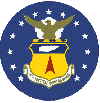 |
Bitburg Air Base,
Germany |
 |
 |
|
Matador TM-61A
1st Pilotless Bomber Squadron
Matador TM-61C
585th Tactical Missile Group |
|
Mace TM-76B (CGM-13B)
71st Tactical Missile Sq
587th Missile Maintenance Sq
|
|
A photo scrapbook of the TM-61C Matador and TM-76B MACE " B" Tactical Missiles at Bitburg Air Base, Germany
and of Special Links to the City of Bitburg and to the Host 36th Tactical Fighter
Wing. |
|
Site 8, Idenheim, in 1966. Awaiting arrival of USAFE inspection team. Note: armed guard above launch bays.
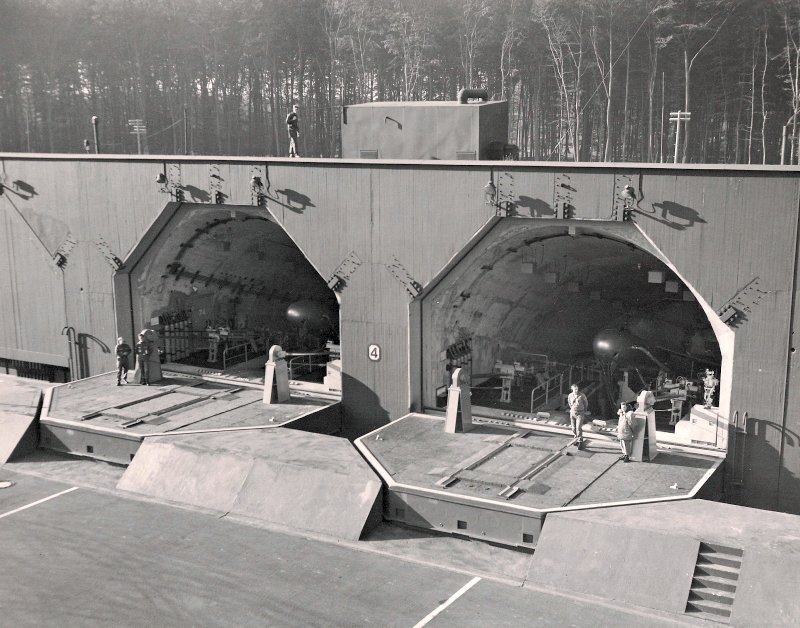
36th TFW photo courtesy of Wayne Douglas, 71st TMS, (lwd2856@aol.com) |
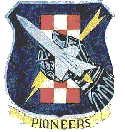
The 1st Pilotless Bomber Squadron |
|
The 1st Pilotless Bomber Squadron, equipped with the B-61A Matador, was assigned to the 36th Fighter Bomber Wing, Bitburg Air Base, Germany, on 31 March 1954, making it the first operational U.S. missile unit.
The 36th Fighter Bomber Wing was renamed 36th Fighter Day Wing (no change of station) a year later on 14 Mar 1955, and the 1st Pilotless Bomber Squadron was renamed to the 1st Tactical Missile Squadron at that time. The B-61A Matador was renumbered to the TM-61A Matador.
The 1st Tactical Missile Squadron was detached from the 36th FDW, no change of station, and assigned to the newly formed 7382nd Pilotless Bomber Group headquartered at Hahn Air Base, on February 1, 1956. The 7382nd was later renamed to the 7382nd Guided Missile Group, and later still renamed 7382nd Tactical Missile Group.
The 7382nd Tactical Missile Group was inactivated on 15 Sept 1956, and the 1st Tactical Missile Squadron was reassigned to the newly formed 585th Tactical Missile Group, Bitburg Air Base, as part of the newly formed 701st Tactical Missile Wing, headquarted at Hahn AB. The unit converted from the TM-61A to the TM-61C during that time. |

Welcome to the 36th FBW, March 1954, courtesy of George Craig, (george8898@hotmail.com) 1st Pilotless Bomber Squadron
|

U.S. Air Force Tactical Missiles By the Editors of this Website!
|
Beyond the Web Page... The only book devoted exclusively to the Matador and Mace Tactical Missiles. The book reveals the story from the initial idea that became the first U.S. pilotless bomber, through the politically troubled development of the ever evolving deployment methods of the Matador and Mace Tactical Missiles. It covers the Units, Groups, Squadrons and Wing that fielded the missiles. From the United States test sites, Europe, Asia and North Africa nothing is omitted. All phases of the application of these two missiles by the U.S. Air Force (and West German Luftwaffe) are included, from the first tentative launches of the XSSM-A-1 Matador in January 1949, to the tense alert duty of the Cuban Missile Crisis, and the final launch of a MQM13A in May of 1977. The maintenance, logistics and launch, the men, equipment and tactics are all there. |
|
"Bob, George, I finished your book 2 days after I received it. Couldn't put it down. It was incredible reading and incredibly detailed information."
Kent Washburn (KWASH55@aol.com) Mace B, Kadena, Okinawa
"George and Bob. I want you both to know how much I enjoyed reading and how much I admire and appreciate what you have accomplished in developing and publishing "The Pioneers". It is truly an outstanding piece of work, reflecting the time and effort required to produce it, but is also a formidable contribution to our military history. I mentioned in some earlier correspondence that I was a little disappointed in the relatively small amount of information regarding the Operating Location/Guidance Sites but you largely made up for it with this magnificent book."
Dale Lake (daleflake@yahoo.com) 601st Tactical Control Squadron, 38th TMW, Hamm, Germany
"I just finished your book, The Pioneers, et al. Please accept my "job well done!" Not only is it informative, but it's very readable. I'd also like to complement you on how well you footnoted it. You have shown that a scholarly work can be both instructive and enjoyable."
Michael Roof (lavinaschnur@hotmail.com) SGM USA (Ret.)
|
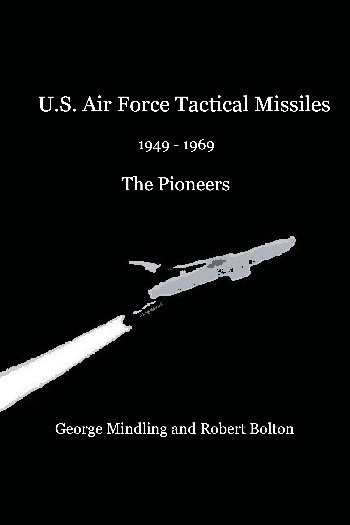
ISBN 978-0-557-00029-6
"Very good work with great detail."
Col. Charlie Simpson, USAF, Retired
Executive Director
Association of Air Force Missileers
"George, the book arrived on Tuesday while I was off to France. Of course, I quickly read the chapter about Germany's quiet step into the realm of nuclear armament. You know, this is still a widely ignored fact over here...
...For me it is fascinating to see what the picture really was in the 1950s and 1960s as opposed to what the official communication of the time wanted people to believe. A fascinating book shedding some light on the early days of tactical nuclear missiles as well as the political background that even today is still largely hidden behind the propaganda of the time. Can't wait to read the rest of it."
Burkhard Domke
Harsefeld, Germany
|
"I have your excellent book on USAF tactical missiles. I actually witnessed the decommissioning of the Maces at Wüscheim back in 1966."
Paul Offen
Talitha, Tye Common Road
Billericay
Essex CM12 9PX
UK
"I just wanted to drop you a line and tell you how much I enjoyed the book that you and Bob wrote. The history was of particluar interest to me and my brother who was a history Professor at the University of Wisconsin. He also thought the book was well written, and he now knows what his little brother, (me), did while in Germany for three years."
George Joseph Snyder (gjsnyder@lanset.com)
71st TMS, Steinborn, Germany
"...by the way, I read your book, it was great, thanks for writing it."
Hack Hunton (hack@sstelco.com) Mace B, Kadena, Okinawa |
|
US Air Force Tactical Missiles
© 2008 - George Mindling and Robert Bolton |
|
Inspired by the 38th TMW Website, George Mindling and Robert Bolton co-authored US Air Force Tactical Missiles 1949 - 1969: The Pioneers © 2008, the story of America's first operational missiles, from the Matador to the Mace, from Taiwan, Korea, and Okinawa to Germany, including Lowry, Orlando, Holloman, Santa Rosa Island at Eglin, and even Camp Happiness! |
|
Dieses Buch ist ein Muss für alle, die im Rahmen ihres Dienstes bei der U.S. Air Force mit den frühen Marschflugkörpern
zu tun hatten, aber auch für deutsche Militärarchäologen, die in der Eifel, im Hunsrück oder im Pfälzer Wald schon
über rätselhafte Hinterlassenschaften gestolpert sind. Nach mehr als 40 Jahren wird endlich eine Fälle von Fakten,
Informationen und Geschichten zu den zwischen 1954 und 1969 in Deutschland stationierten, mit Automwaffen ausgerüsteten
amerikanischen Matador und Mace auf den Tisch gelegt.
Ausfährlich und lebendig erzählen George Mindling und Bob Bolton von den jungen Missilemen, die im März 1954 erstmals in Bitburg ankamen -
noch ganz grün im Gesicht, weil auf dem Atlantik schwerer Sturm geherrscht hatte. Von den T-33-Flugzeugen, die aus übungsgründen so taten, als
wären sie Matador-Flugkörper, äber die Startstellungen hinweg in Richtung deutsch-deutsche Grenze donnerten und sich von der Gegenseite
nur nicht erwischen lassen durften. Oder von der Kuba-Krise, als die US Air Force Europe auf DEFCON 3 ging und an die Mechaniker in
Bitburg Munition für ihre Karabiner ausgegeben wurde.
Augenzeugen sagen dazu: "Wir hätten die Vögel auf jeden Fall innerhalb von 15 Minuten in der Luft
haben müssen!" Es ist lebendige Militärgeschichte, die nun nicht der Vergessenheit anheimfällt, sondern
jedermann zugänglich wird - auch für die ortsansässige Bevökerung, die heute endlich erführt, was sich damals
in ihrer Nachbarschaft zugetragen hat. Den beiden Autoren gebührt der Dank.
Klaus Stark (klaus_stark@t-online.de)
Berlin, Germany
This book is not only a must for all those who served in the U.S. Air Force with the early cruise missiles, but also for German military archeologists who have been puzzling over relics stumbled across in the Eifel, the Hunsrück and the Palatinate Forests. After more than 40 years, we finally have a wealth of facts, information and stories, from 1954 to 1969, of the nuclear equipped American Matador and Mace missiles stationed in Germany placed on the table.
With detailed and vivid descriptions, George Mindling and Bob Bolton talk about the young Missilemen who arrived for the first time in March, 1954, in Bitburg - still green in the face, having prevailed the Atlantic crossing in major storm. Of the T-33 aircraft which practiced as if they Matador missiles launched in the direction of German-German border, or from the Cuban missile crisis, when the U.S. Air Force Europe went on DEFCON 3 and was issued ammunition to the mechanics in Bitburg for their rifles. Eyewitnesses say: "We would have to have the birds in the air in any event within 15 minutes!"
It is vital military history that is prey to oblivion, but is now accessible to everyone - even for the local population, which today finally learns what happened at that time in their neighborhood.
The two authors deserve thanks for saving the history.
Klaus Stark,
klaus_stark@t-online.de
Berlin, Germany
|
|
 |
The 1st TMS was inactivated and replaced by the 71st Tactical Missile Squadron 18 Jun 1958, reporting to the 585th Tactical Missile Group, 38th Tactical Missile Wing, which was activated the same day at Hahn Air Base, Germany, replacing the inactivated 701st TMW.
On 1 September 1959, Sembach became USAFE's primary missile base when the 38th Tactical Missile Wing headquarters moved from Hahn Air Base to Sembach Air Base. The three Tactical Missile Groups assigned as part of the 38th TMW in 1958 continued with their assignments: the 587th TMG at Sembach, the 586th TMG at Hahn AB, and the 585th TMG at Bitburg AB. The 585th TMG consisted of the 71st Tactical Missile Squadron, the 585th Missile Maintenance Squadron, and the 585th Support Squadron.
The 585th Tactical Missile Group was inactivated 25 Sept 1962, also deactivating the last TM-61C Matador, and the 71st TMS was assigned directly to the 38th Tactical Missile Wing, Sembach AB, while the 585th Missile Maintenance Squadron became Detachment 3, 38th Missile Maintenance Squadron (36th TFW SO A-694 24 Sept 1962). 1 July 1964, all personnel in Det 3, 38th MMS were transferred to the 587th Missile Maintenace Squadron (36th TFW SO A-912 17 June 1964)
The 587th Missile Maintenance Squadron was merged into the 71st Tactical Missile Squadron 1 Oct 65 (36th TFW SO AA-84 29 September 1965).
38th TMW was inactivated 25 September 1966, and the 71st TMS became part of the host 36th Tactical Fighter Wing. The 71st TMS, a combined launch and maintenance squadron, remained on duty for almost three more years with the CGM-13 B Mace as part of the host 36th Tactical Fighter Wing.
The 71st TMS was inactivated and all personnel transferred to the 36th Combat Support Group 30 April 1969 (36th TFW SO P-109 3 April 1969). The CGM-13B (TM-76B) Mace was also inactivated, the last US Air Force tactical missile in Europe at that time, marking 15 years of continuous combat service in NATO for the US Air Force tactical missiles.
The CGM-13B Mace continued in operational service with the 498th Tactical Missile Group at Kadena Air Base, Okinawa, until September, 1969.
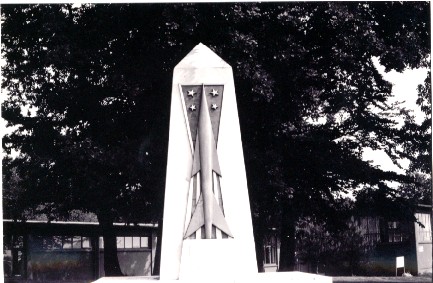
Photo taken in 1968 by George Kovach
(gfkgdk@aol.com)
The Missile Monument located in front of the Base
Library and Education Office
The Monument was dedicated to the first Matador crews in
Germany
|
|
The Monument was an exact representation of
the original Missile Badge. the famed "Pocket Rocket."
The Badge was designed by Col. Fred W. Vetter, Jr., commander of the 585th Tactical Missile Group. |
|
"I particularly would like to see the photos of the "Missle Monument", which I am told has now been removed and destroyed. I have a two foot high model of it here. We brought the aluminum all the way from Tripoli after one of our annual missle shoots into the desert using the TM-61C. That meant driving over almost six hundred miles of desert to the target area,
collecting the pieces of birds previously fired, and hauling them back to Bitburg ---
George Ingersol, cmdr of the 71st TMS, and a great guy -- the only West Pointer
in Group, was the hero of that exercise. A S/Sgt Henry (Hank) Kreuger, and one hell of an artist, clown and truly nice guy, drew the final layout of the monument, set the dimensions,
specs., etc. I'm darned if I can recall who the caster of the missile
badge was, but the mason contractor who did the erection was the same
German firm that helped build the three skeet/trap ranges we put in on
the East end of Bitburg, and ended up with the contract for the B cells
you helped wire.
Oh my, what a big affair it was to dedicate the thing! The
marble that faced the obelisque was hauled in from Italy in an old C-47.
My recollection is that we did this around 1959".
Brig. Gen. Fred W. Vetter, Jr., USAF, ret. |
 |
|
The Marble Missile Monument was moved from Bitburg sometime in the late 1980's or early 1990's. It's new location has been a mystery that is still being unraveled. However, it appears the skeleton of the monument, stripped of the marble and the badge may have been located at Wüscheim, now called Pydna. The story and photo are in the above link. |

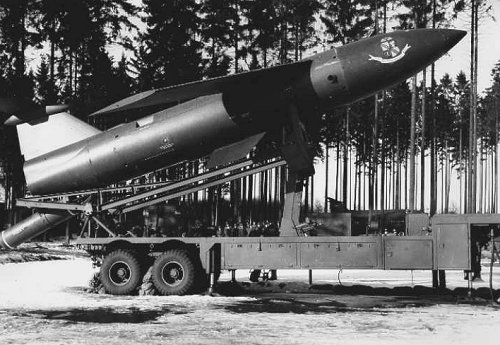
The TM-61C Matador Show Bird at Bitburg, 1957
Matador photo courtesy of Paul Yadon (eatarn84029@yahoo.com) |
Family day at B-pad Rittersdorf
585th Tactical Missile Group, Bitburg Air Base, Germany, 1957
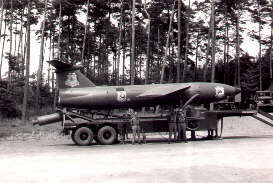
"... I don't remember any of the people, these pictures are from
Paul Yadon. This was "B" pad in the early days of '56 or '57. I remember the show
bird when I got there. This was the show pad at that time and later when Col.
Vetter took over he got the funds to get us out of the mud. They
painted two missiles sky blue and we used them at all three pads when there
was a show to put on." |
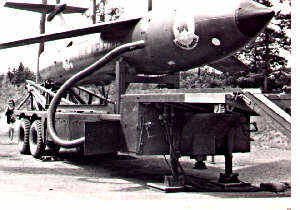
"We were cute! Red beret, red scarfs, bloused boots with white shoe laces. At first, the fighter Sq people would make fun of us when we came on base with our
dress uniform . They would try to speak French to us ! some of the guys
would not wear it unless they had to."
|
|
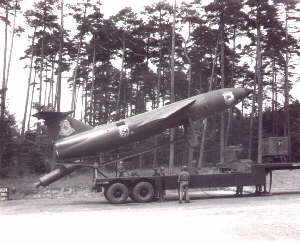
"We were the the first missile people to wear the Missile Badge in the Air Force at that time. Hopefully everyone knows that Col. Fred W. Vetter was the
designer ot the Missile badge, and the Matador and Mace people owe him a lot
for the upgrades he did for them in the beginning. I know, I was there !!..."
Roy Mathis ingroy@aol.com |
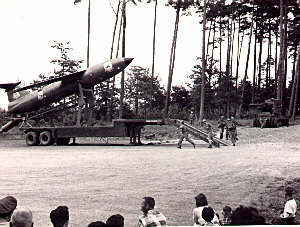 |
|
Matador photos submitted by Paul Yadon
(eatarn84029@yahoo.com)
|

|
It is a small world, indeed!
Read the recent Mahl-ish article in the magazine of the Air Force Museum Foundation,
the
"Friends Journal"
Winter
2025, Vol. 48 No. 1

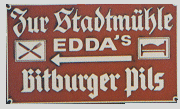
Bitburg Air Base - Summer of 1961
The Housing Area gate
Photo courtesy of Ed Cole
(LMCENC@aol.com)
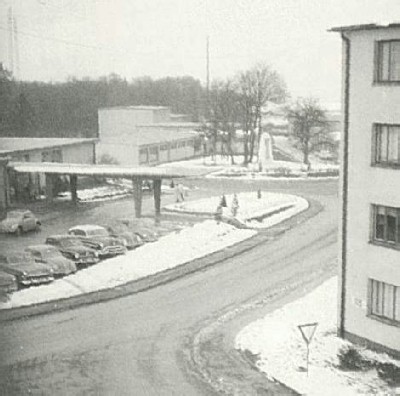 |
Bitburg Air Base, Feb 1962
The view from the 585th MMS - 71st TMS barracks, looking past the NCO club and the 525th
FIS barracks toward the Missile Monument on a typical winter day. The Base Library is behind the
Monument, the service club and AFEX Snack Bar are just down the hill.
The Missile Monument, dedicated to the first 38TMW
TM-61C Matador crews and detailed earlier on this page, is visible on the corner. |
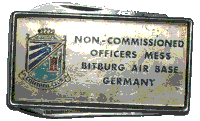

|
"We were laying on our bunks as there was only room for two
chairs in our small, 4th floor room, smoking and watching the snow blow between the barracks
in the eerie street light. It had been snowing for several days without let up. Driving off
base was dangerous as the snow was so high it covered the tops of the white kilometer markers
on the most of the open highways. Another miserable night to be outside when the CQ runner
stuck his head in the door and said, "Steinborn is snowed in! We're looking for volunteers
to go up and shovel snow so the launch crews can get some rest. Any takers?"
We all agreed it was the thing to do as we pulled on our thermal underwear and fatigues.
We wore combat boots with bloused pants and the newly issued parkas. We knew we might be
there a few days, so shaving kits and tooth brushes got stuck into the parka pockets along
with extra socks.
We formed up between the barracks in the dimly lit street with the snow
swirling between the buildings and waited for the 6-byes with chains that were to take
us up to the Matador launch site in the Eifel mountains. There were twenty or so volunteers
standing at rest in the silence, smoking and lightly joking about being dumber than doorknobs
for volunteering for anything. Soon, a 6-By in chains lumbered up out of the dark
and pulled alongside the barracks across the street. The canvas flaps were pulled back and the
tailgate slammed down, but we remained in formation. We stood in the softly blowing snow and waited, but we didn't know why.
Soon, a beautiful Facel Vega, a French bodied Chrylser, pulled up in the Staff Car parking slot and out got our Group Commander, in uniform. He had driven up from the American housing area in Trier, some twenty miles away.
Col. Fred W. Vetter, Jr., Commander, 585th Tactical Missile Group, moved
down the ranks one by one, personally shaking hands and thanking every volunteer that night.
He made an impression on our astonished group that midnight in the snow, and I'm sure he is
remembered by all who ever served under his command."
George Mindling (myakka@embarqmail.com) |

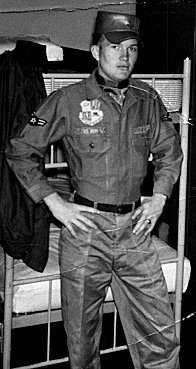
A2C Ira (Denny) Young, AGE, (left) models the Alert Uniform of the
Day of the 585th Missile Maintenance Squadron, including the baby blue faux leather cap
(naugahyde) with matching blue alert scarf and blue nametags with yellow
lettering, 1962.
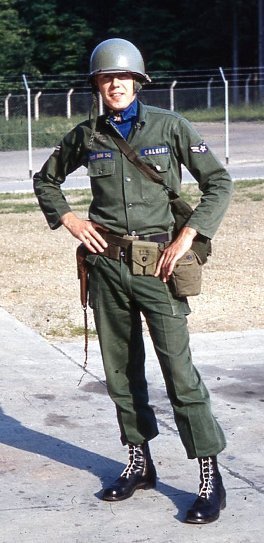
The colors used previously by the 585th MMS included orange hats, scarves, and
nametags with black lettering. The colors were switched as the Mace replaced the Matador
in the squadron.
A2C Len Calkins, GSC, (right) in full alert regalia, including Jim Larimer's famous "coffee ground" helmet. During most alerts, crews wore the gas masks strapped upside down to the outside of the left leg to keep it out of the way as they scrambled around test equipment, launchers, airframes and trailers.
On September 24, 1962, the unit was renumbered as Detachment 3, 38th Missile
Maintenance Squadron. Two years later, on 1 July 1964, the unit was renumbered to the 587th
MMS, reverting back to standard USAF fatique uniform.
The colors used by the 71st Tactical Missile Squadron were red caps, name tags and
scarves. The Tactical Missile Squadrons were comprised of the Missile launch crews.
The 71st never swerved from the red caps.
Photos courtesy of Ira Young (ira@irayoung.com) and Len Calkins (lcalkins002@cfl.rr.com)
|

Combat alert scarf of the 587th MMS, available for purchase at the orderly room.
Scarf courtesy of Jim Larimer, GSC (jalarimer@gmail.com) |

|
The 585th Tactical Missile Group was inactivated 25 September 1962 as the last TM-61C Matador Missiles in Europe were inactivated with the closure of "A" Pad at Steinborn, "B" pad at Rittersdorf, and "C" Pad at Idenheim. The Matadors had been in constant alert duty at Bitburg for eight years with the 1st and 71st Tactical Missile Squadrons. The 71st Tactical Missile Squadron, outfitted with the Martin-Marietta TM-76B Mace since early 1962, was attached directly to the 38th TMW, while the 585th Missile Maintenance Squadron became Detachment 3, 38th Missile Maintenance Squadron (36th TFW SO A-694 24 Sept 1962). The first model "B" Mace went operational at the new Rittersdorf Hard Site, renumbered 38th TMW Site 7, June 27, 1964.
On 1 July 1964, all personnel in Det 3, 38th MMS were transferred to the 587th Missile Maintenace Squadron (36th TFW SO A-912 17 June 1964)
The 587th Missile Maintenance Squadron was merged into the 71st Tactical Missile Squadron 1 Oct 65 (36th TFW SO AA-84 29 September 1965). The 71st TMS, a combined launch and maintenance squadron, remained on duty for almost three more years with the CGM-13 B Mace as part of the 36th Tactical Fighter Wing.
. The TM-76B, renumbered to CGM-13B, was inactivated in USAFE as well, but remained in service in PACAF with the 498th TMG at Kadena Air Base, Okinawa. |
|

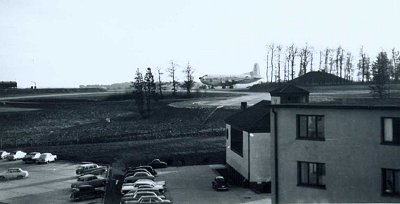 |
|
A C-124 Globemaster sits on the apron
behind the base chapel.
Photo from the roof of the AP barracks by Ed Cole
(LMCENC@aol.com) |
|
Armed Forces Day Open House, 1964. A display TM76B Mace on a
launcher/transporter provides a good vantage point to watch the airshow. |
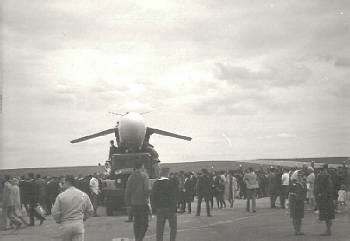 |
|
The base chapel at the end of the street, and the main mess hall on the right.
Photo taken from the top floor end bay of the
585thMMS/71TMS barracks before the
base was camoflaged |
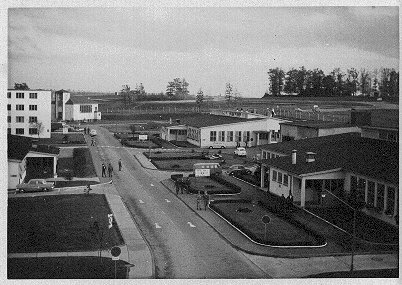 |

|
"Sometime after conversion to the Mace began (by the 38th TMW at Bitburg), I arrived at the 36th in October 1962 as a new 2nd LT and was assigned to the 36th CAMRON as Assistant OIC of the flightline, having responsibility for all the squadron's F-105s. We had a severe personnel shortage, with usually a ratio of less than one crew chief per bird on the Frag. Due to slippage in the construction of the new launch facilities, the 38th had a lot of people with no visible means of support. There was a joint meeting of the two Wings and my section wound up with a group of missile maintenance folks. Every day for almost a year I had an augmentation force to assist in preflight, launch, recovery, and line maintenance on the Thuds. Some days I had more missile folks working than Thud folks."
"There was many a Thud driver who, not knowing what had transpired, climbed into his F-105D, was assisted by the ground crew, taxied out, received a "High Ball," and went his way without knowing that the whole operation had been carried out by 38th TMW maintenance personnel. When some stick shakers questioned the use of the missile personnel, we just pointed out that the only significant difference between the Mace and the Thud was one had a live pilot and one had a mechanical pilot and the airframe really didn't care which was in control. We really missed the missile folks as they drifted away a few at a time as the 38th gradually came on line.
"My hat is off to a great bunch of folks who more than once saved the day. My best personal wishes and a belated thank you to all the folks of the 38th TMW/71st TMS who gave a helping hand to a very young and inexperienced 2nd LT maintenance officer."
- Al Mikutis, Member of the Association of Air Force Missileers (AAFM), in the December 1998 AAFM Newsletter (Volume 6, Number 4), Page 6
Special Thanks to the late Dave Gurtner for including the above passage on his excellent web site "The Thuds at Bitburg"
|

CGM-13B Mace and F-105D at Bitburg Air Base Open House, 1966
36th TFW photo courtesy of Wayne Douglas, 71st TMS, (lwd2856@aol.com) |
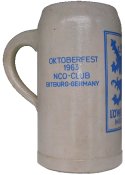 |

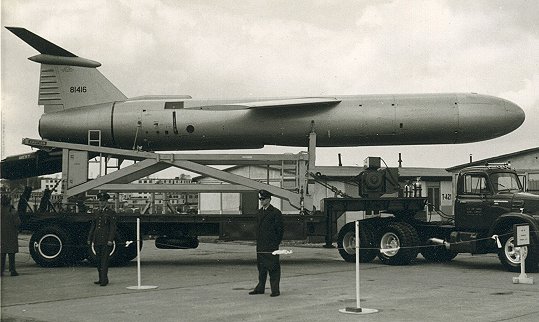 |
A TM-76B Mace (58-1416) of the 71st Tactical Missile Squadron on display at Bitburg Air Base during Open House, Armed Forces Day, May 11, 1963. A1C Glen Curl, E&A, left, and A2C Gerry King, MEMS,center, wearing the sinister looking raincoat. The missile, with an empty nose section, is devoid of markings except for the tail number and the ever present US Air Force red turbine warning stripe always found on the aft section of all US Air Force jet-powered vehicles. The inertial guidance system which required constant gyro heater power was removed from the nose section for all static displays. The missiles were renumbered later in the year to CGM-13C and redesignated again the following year to CGM-13B, their final designation. |
|
Photo courtesy of George Mindling (myakka@embarqmail.com) |


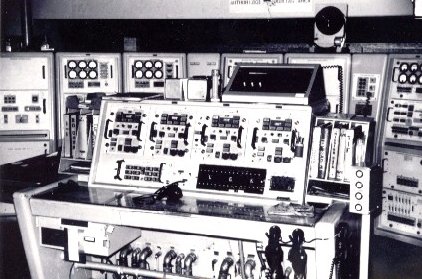
A Launch Command and Status Console (LCSC), in a Launch
Control Center, 60 feet underground in one of the "hardened" launch sites.
Photo courtesy of George F. Kovach (GFKGDK@aol.com) |

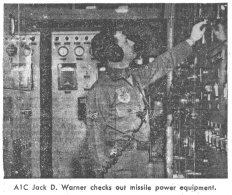
USAF Photo
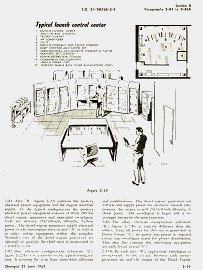
|
"My favorite story about the MACE "B" and Bitburg took place after the
38th TMW had been disbanded and the 71st TMS was officially part of the 36th Tactical
Fighter Wing.
I was the chief of Missile Standboard as a 1st/LT and the wing was about to
undergo an ORI. USAFE had sent down 2 Captains that had been in the MACE "A"
at either Hahn or Sembach. They had never been in a MACE B site, much less underground.
When they arrived on base they came to my office, introduced themselves, and then asked
how my standboard crew "certified" the 71st TMS crews. I explained the process
and then they asked me to select 4 crews to run through the procedures. Naturally, I
selected the 4 best crews in the 71st. Then they asked me to take them and the crews
out to a site to be evaluated. I took them out to Idenheim and they thought the weather
cover building over the stairs were the Launch Control Centers. Never having been underground,
they were a little apprehensive about going down.
They asked our standboard crew to "evaluate" the 4 crews. We ran them
through standard EWO and right out of the book emergency procedures. Then the evaluators
asked me how the crews had performed. Naturally, they had done an "outstanding"
job. The evaluators then asked me to write up a report and this appeared word for word in
the Wing ORI and the 71st received an Outstanding Evaluation.
Will wonders never cease!"
Gill Goering, Col, USAF (retired)
1st Lieutenant at the time (GillG@aol.com) |


|
"I was on a launch crew from 1963-66 at the
Rittersdorf site... sure remember all those 12hr shifts... and all the pinochle games.
I was maintenance and paired with the Nuke guy....we found out how to get Armed
Monitor Unsafe in our checks... So if we got a new launch commander we would hook it in for his
experience and see how he handled it.
Remember when we got there they had the launch crank away from launch buttons.
Said it was so it took two people to launch. Well, we had one tall, lanky guy on one of the
crews... he showed them that he could crank the pwr gen with his foot and hit the launch buttons.
They had to change locations."
Thanks for the memories
Robert Bimbi - was A1C (rbim@peoplepc.com) |

USAFE Launch Bay Inspection, Idenheim, 1966. Lt. Gen. Richard Mattern Montgomery, Vice-Cmdr USAFE with Lt. Col Joseph Smejkal, 71st TMS Commander and other USAFE Staff officers.
36th TFW photo courtesy of Wayne Douglas, 71st TMS, (lwd2856@aol.com)
|

|

Security and the Missile Sites |
|
"A little history
of the K-9 Section. The 36th AP's had their dogs and the 585th Missile Sq. had their
dogs, all housed in the same kennel. When I got to Bitburg in March 1961, the 36th took
care of the Zulu area, the 500 bomb storage area and the uploaded F-105's on the hardstand
and the rear outside perimeter of the base. The 585th took care of the Matador sites and new Mace
sites.
Shortly thereafter, the 585th came over to the 36th as one group and we
shared the duty of all areas. The reason no one would know the kennel area is
that we only worked the dogs from dark till dawn. The areas we went to were
unoccupied. We did put on demos for the public, but they were the dogs that
were extremely obedient. The more vicious ones, such as my dog Pete, were kept
away from everyone."
Ed Cole, K-9 Handler, 36th AP Squadron (LMCENC@aol.com) |
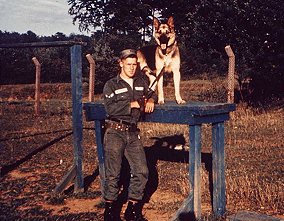
Ed Cole and Pete "2"
(LMCENC@aol.com) |
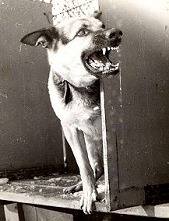
Pete "2" |


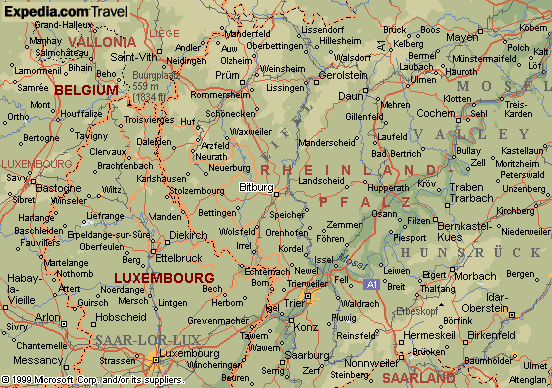 
|
There are many fond memories of Bitburg and of the Eifel. Many of us met our wives here, and there were more children born at the 36TFW Hospital at Bitburg Air Base than there are inhabitants of Bitburg! |
Check for youself at the City of Bitburg's Homepage
 |
|
This page is in no way sponsored or endorsed by the United States Air Force.
Opinions and views expressed are those of the author and not necessarily those of the
Department of the Air Force.
|
Web Page Design and Development by
George Mindling - Port Charlotte, Florida
© George Mindling - 2003-2006 All Rights Reserved
|
|

